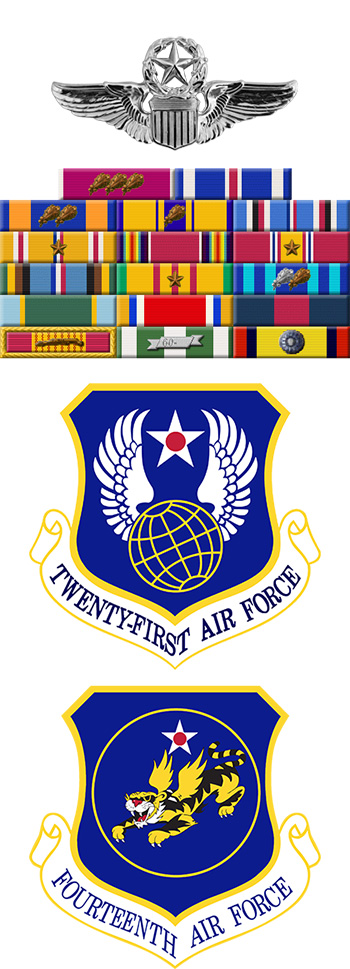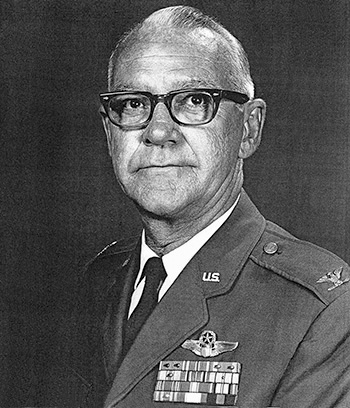
|
Heyward A. Paxton, Jr. |
 |
|||
| Rank, Service | ||||
Colonel O-6, U.S. Air Force |
||||
| Veteran of: | ||||
|
||||
| Tribute: | ||||
Heyward Paxton was born on March 20, 1921, in New Smyrna Beach, Florida. He enlisted in the U.S. Army on March 31, 1942, and entered the Aviation Cadet Program of the U.S. Army Air Forces on June 17, 1942. Paxton was commissioned a 2d Lt and awarded his pilot wings at Napier Field, Alabama, on March 25, 1943, and then served as an instructor pilot with the 304th Fighter Squadron at Pinellas AAB, Florida, from March 1943 to July 1944. His next assignment was as a P-40 Warhawk and then P-51 Mustang pilot with the 7th Fighter Squadron (Provisional) of the 3rd Fighter Group (Provisional) with the Chinese-American Composite Wing in China from September 1944 to February 1945, followed by service as Assistant Operations Officer of the 3rd Fighter Group from February to April 1945. During this time Capt Paxton was credited with the destruction of 6.5 enemy aircraft in aerial combat, 8 damaged in the air, and 5 destroyed on the ground while strafing enemy airfields. He was also shot down on January 14, 1945, and evaded capture, returning to allied lines on January 27, 1945. He served as an instructor pilot with the 336th Army Air Force Base Unit at Sarasota, Florida, from April 1945 to February 1946, followed by service as Commander of the Headquarters Squadron and then as Operations Officer and Plans and Training Officer for the 544th Air Service Group at Lake Charles AAF, Louisiana, from March to December 1946. Capt Paxton served as a Squadron Adjutant and then Squadron Commander with the 544th Air Service Group at Biggs Field, Texas, from November 1946 to July 1947. His next assignment was as a Flight Test Officer and Adjutant with the 47th Maintenance Squadron at Barksdale AFB, Louisiana, from July 1947 to February 1949, followed by service as Operations Officer and Aircraft Maintenance Officer with Headquarters Squadron of the 47th Air Base Group at Barksdale AFB from February to June 1949. Maj Paxton next served as an Aircraft Maintenance Officer with the 1225th Air Base Group at Pepperrell AFB, Newfoundland, from September to November 1949, and then as Commander of the 1225th Maintenance Squadron at Pepperrell AFB from November 1949 to July 1950. He served as A-3 Officer with the 6602nd Air Base Wing at Ernest Harmon AFB, Newfoundland, from August 1950 to June 1952, followed by Air Command and Staff College at Maxwell AFB, Alabama, from June to December 1952. Lt Col Paxton next served as an Instructor at Air Command and Staff College from December 1952 to November 1953, and then as an Education and Training Staff Officer at RAF Staff College Bracknell, England, from December 1953 to January 1956. His next assignment was as a Staff Officer and then Branch Chief with the Office of Legislative Liaison at the Pentagon from January 1956 to August 1958, followed by service as Assistant Chief of Staff, Director of Tactical Systems Testing, and then Assistant to the Deputy Chief of Staff of Development and Testing with Headquarters Air Proving Ground Command at Eglin AFB, Florida, from September 1958 to August 1961. Col Paxton attended the Industrial College of the Armed Forces at Fort McNair, Washington, D.C., from August 1961 to July 1962, followed by service as Director of the U.S. Joint Operations Command with Detachment 1, 13th Air Force, at Taipei, Taiwan, from July 1962 to August 1964. During this time he participated in missions into South Vietnam from December 1962 to June 1963. His next assignment was as Commander of the 1st Combat Applications Group at Eglin AFB from August 1964 to July 1966, and then as Chief of the Air Section in the Combat Readiness Branch with Supreme Headquarters Allied Powers Europe (SHAPE) at Louveciennes, France, and then at Mons, Belgium, from July 1966 to June 1967. Col Paxton then served as Executive Officer to the Assistant Chief of Staff of SHAPE at Mons, Belgium, from June 1967 to September 1969, followed by service as Chief of Staff with Headquarters 21st Air Force at McGuire AFB, New Jersey, from September 1969 until his retirement from the Air Force on April 1, 1972. Heyward Paxton died on November 18, 1998, and was buried at Sea Pines Memorial Gardens in Edgewater, Florida. |
||||
|
||||

